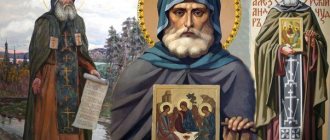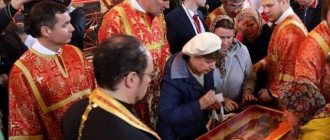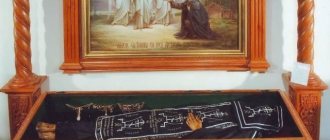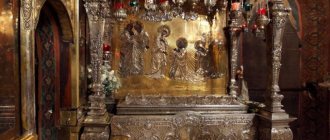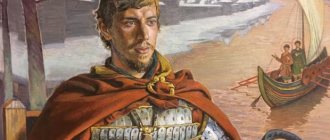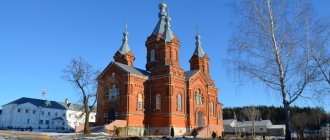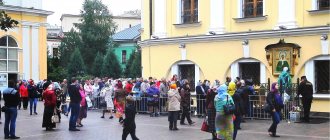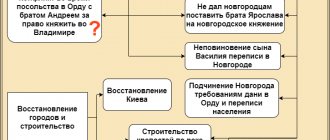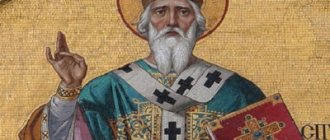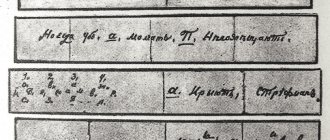The Holy Trinity Monastery, where the relics of Alexander Svirsky are located, annually receives thousands of pilgrims from all over the world.
Believers long to see the incorruptible body and the beauty of the myrrh flowing from the feet and palms of the elder wonderworker.
The relics are more than 5 centuries old, but even now the face of Alexander Svirsky has been preserved and is similar to his images on ancient man-made icons. Moreover, the incorruptible relics of the holy elder still have a constant temperature of a healthy human body - 36.6 degrees.
Brief biography of Alexander Svirsky
We can say that the entire biography of St. Alexander Svirsky is a continuous spiritual feat of prayer. After all, even after death, he continues to pray for believers, being among us in an incorporeal form. Until now, he helps believers who have wavered in their faith to strengthen their faith, or find a long-awaited child, or strengthen their spiritual and physical health. The mother and father of the venerable elder were pious people and, raising their 2 eldest daughters, they prayed for the granting of a long-awaited son to them. During the service, they heard the voice of God, which told them about the imminent fulfillment of their cherished desire.
A miracle appeared, and on June 15, 1448, a wonderful boy was born into a family of simple peasants. His birth fell on the day of the holy seer Amos, in whose honor the beautiful baby was christened. The parents wished for a better life for their son and, as a teenager, sent him to study literacy and various sciences.
Reading and writing were difficult for young Amos; he fell into melancholy and despair. Only a visit to the Ostrog Vvedensky Church gave the teenager strength, and during the moments of worship he saw the miraculous face and heard the voice of the Mother of God.
Young Amos grew up to be a strong and modest guy, wore robes and avoided fun and noisy celebrations. At the age of 19, having refused to marry, he left his father’s house and went to the Valaam monks. Having reached the source of the Svir, Amos moved to the opposite bank and soon found himself near a picturesque lake.
Here he decided to spend the night and spend time in long prayers. Late in the evening, in complete darkness, a miracle happened: a bright light descended on the chosen holy place. The Voice of God told the humble Amos to go to the monastery on Valaam, but then return to this place and found a monastery here.
This is interesting: a young man got lost on the road to Valaam, but a lonely traveler led him out of the forest, and then suddenly disappeared, and young Amos believed that a real Messenger of God had led him out of the forest.
Important events in the life of St. Alexander of Svirsky:
- For 7 years Amos lived as a servant of the monastery and, with the blessing of the abbot, took monastic vows on August 26, 1474. He was named Alexander;
- In 1485, during the moments of night vigils, the face of the Most Holy Theotokos appeared to the monk Alexander, a voice from heaven ordered him to return to the holy place, and the pointing finger was directed towards the reserved lake;
- Not far from the Svir River, the monk Alexander erected a small cell. He lived the first 7 years without tasting bread, without seeing a single living soul, eating only the gifts of the forest. Visions healed him from illnesses, and God’s voices guided him along the true, difficult and thorny path;
- Rumors about the venerable hermit spread throughout the area, and pilgrims began to flock to Alexander. In 1508, an already middle-aged monk, who had been living in a secluded place for more than 20 years, saw the theophany of the Holy Trinity;
- Alexander was given a place to build an Orthodox church. At first it was a wooden church, and in 1526 the first stone church arose instead;
- Soon the reverend monk accepted the abbess, and, without retreating from his divine mission, continued the construction of shrines for the glory of the Most Holy Theotokos.
Blessed Alexander Svirsky went to a better world on August 30, 1533, at the age of 85. He bequeathed to bury him in a swamp or wasteland. But the successors did not follow the elder’s behest and decided to preserve the relics of the pious for future generations.
We are sure that you will be interested in the article about the Transfiguration Cathedral in St. Petersburg.
What to ask a saint for
Many people come to the monastery to venerate the holy relics, because during his lifetime Father Alexander was responsive to weaknesses - he prayed and asked for the people who came to him, performed many miracles with the power of the Holy Spirit and prayer.
Holy Trinity Alexander Svirsky Monastery
Especially often, through his prayers, married couples became parents; since then it is believed that childless couples (especially those suffering from infertility) should definitely go and read a prayer at the relics of the saint:
Reverend and God-bearing Father Alexandra! Humbly falling before the race of your honorable relics, we pray to you diligently, raise up your hands for us sinners to our Lady Theotokos and Ever-Virgin Mary, as if He would remember His ancient mercies, in whose image He promised to be persistent from your monastery; and will give us strength and strength against our spiritual enemies, who lead us away from the path of salvation, so that when they appear as victors, on the day of the Last Judgment we will hear from you a praiseworthy voice: Behold, even the children that you God have given me! and we will receive a crown of victory from the conqueror of the enemies of Christ, the Son of God, and together with you we will receive the inheritance of eternal blessings; chanting the Most Holy Trinity, the Father and the Son and the Holy Spirit, and your merciful intercession and intercession, now and ever and unto ages of ages. Amen.
In addition to requests for the gift of a child, the saint is also approached with other petitions for:
- spiritual and physical healing;
- gaining faith;
- giving strength in trials;
- seek blessings when becoming a monk.
There are many known miracles that are recorded by monks and serve to strengthen faith in the Lord Jesus Christ. A particularly famous story is about a girl with damage to the central nervous system. Her mother, with the permission of the abbot of the monastery, placed her daughter on top of the glass lid of the reliquary. The girl could not walk, but after a short stay on top of the relics she stood up and began to walk on her own. The people around them were amazed by what they saw and immediately glorified the Lord for the miracle. Miracles of healing from cancer and blindness are known, and there are many testimonies of healings from infertility in men and women.
Many miracles also occurred during the movement of the shrine to the Church of Faith, Hope and Love in St. Petersburg. Then many people came to honor the memory of the saint who had died more than 500 years ago and offer prayer to the Lord. At that time, many miracles happened and people for a long time told their testimonies to the abbots of the temple, confirming the miraculousness of the saint’s ashes. The pilgrimage movement continues to actively visit the Svir Monastery, hoping to get answers to their questions.
Holy Trinity Alexander-Svirsky Monastery
Relics of St. Rev. Alexander Svirsky lie in the Holy Trinity Alexander-Svirsky Monastery, which is located in the Lodeynopolsky district of the Leningrad region, in the village of Staraya Sloboda. The Holy Trinity Monastery of St. Alexander of Svirsky became a spiritual center and educational cradle of the entire Olonets region. In the northern regions of Russia, the fame of the wonderful old man and his Orthodox monastery spread throughout the cities and villages.
Interesting Facts:
- The settlement of Olonets was developed thanks to the enormous help of the holy brethren and the direct contribution of St. Alexander;
- In 1703, during the foundation of St. Petersburg, the temple, headed by its founder, provided great support to the builders of the great city;
- During the period of the Lithuanian attack, during the war with the Swedes and during the bloody battles of 1812, the monastery donated food supplies and made huge material contributions to the military needs of the state;
- The monastery kept memorial letters, vestments and liturgical vessels from the great Tsars Mikhail Fedorovich, Ivan the Terrible, Alexy Mikhailovich and Peter the Great.
The Holy Trinity Alexander-Svirskaya Monastery is one of the ancient architectural monuments and great Orthodox shrines. The founding date of the monastery is considered to be the end of the 15th century. During the life of the sacredly revered Alexander of Svirsky, the Church of the Intercession, the Trinity and Transfiguration monasteries with fraternal cells were erected.
In the fall of 1918, the temple was looted and during the Soviet Union there was a forced labor camp here. In the period from 1953 to 2009, it housed the Svir hospital for cripples and the mentally ill.
Biography of the righteous
He was born into a modest peasant family, in the remote village of Mandera, Olonets region. Parents (Stephen and Vassa) prayed for many years that the Lord would send them an heir. The long-awaited son was named after the biblical prophet Amos. The boy did not show much success in his studies; from an early age his heart was given to God. Having reached adulthood, the young man fled to the Valaam Islands to join the local brethren.
Seven years later, the novice became a monk, receiving a new name - Alexander. He retired to an island, where he spent his life in a cave, praying.
- 1485 - the ascetic receives the blessing of the abbot and moves to Karelia, to a lake near the Svir River. Today there is the Alexander-Svirsky Monastery.
- 1506 - appointed to the position of abbot (manager of the monastery).
- 1508 - appearance of the Holy Trinity.
- 1533 - death day.
- 1545 - a disciple of the righteous man compiled his biography.
- 1547 - at the Makarievsky Cathedral he was canonized to the rank of saint.
Work as a courier at Yandex.Eda (up to 3,400 rubles per shift) leave a request →
The monk spent a quarter of a century in seclusion, after which the Holy Trinity appeared to St. Alexander of Svirsky. The saint saw three men in shining clothes. He fell to the ground, considering himself unworthy of such a visit. The Lord commanded Him to erect a new temple and blessed Him for further spiritual exploits.
Above the place where the righteous met with God is now the Chapel of the Holy Trinity.
The incorrupt relics of St. Alexander of Svirsky
The life of the righteous Alexander of Svirsky was described in 1545 by his successor Herodion at the direction of Theodosius, Archbishop of Novgorod.
The narrative testified to the elder’s numerous exploits, the miracles of theophany, predictions of the future and the abbot’s healing of hopeless patients. By order of the highest clergy, after 2 years a service was held, and the day of memory of St. Alexander began to be celebrated.
On April 17, 1641, the holy remains of Alexander Svirsky were declared incorrupt and transferred to the Transfiguration Church to the joy of the believing parishioners. When they lifted the lid of the coffin, a strong fragrance wafted from the relics, and everyone saw the body of the miracle worker untouched by time, although more than 100 years had passed since the burial.
An interesting fact: many of those who were able to touch the hands of Alexander Svirsky with their lips assured that the relics were warm, like the body of a living person. The remains of the holy martyrs continue to radiate warmth and energy even centuries after the death of the great saints.
The news spread everywhere and reached the chambers of Tsar Mikhail Fedorovich himself. He granted a silver tomb for the holy remains, inlaid with stones and other valuables.
The history of the discovery of the relics and the canonization of the saint
Alexander Svirsky became one of the few saints whose canonization was carried out quite quickly after his death. Namely - 14 years later, in 1547 at the Makaryevsky Cathedral. Historians are inclined to believe that this was largely due to the important victory for the Russian army over the Kazan prince Epancha, which miraculously fell on the day of veneration of the saint.
The relics were found in April 1641, incorrupt. What became another greatest miracle of the Monk Saint Svirsky. After the discovery of such a valuable Orthodox shrine, people from different parts of Russia rushed to the sacred shrine, eager to touch their beloved saint and pray to him.
However, since 1918, this Christian shrine was destined to go through many tests. Having been taken out of the temple by the Bolshevik commissars, the remains of Alexander Svirsky were first subjected to a thorough examination. Imagine the surprise of the scientists who discovered that the holy relics were really real, and not, as they assumed, a “wax doll.” Having learned about this, the political leadership ordered to hide the body of the saint so that no one would ever find it. For this purpose, it was transferred as a biological exhibit to the museum of the Military Medical Academy named after. Kirov.
It is not known what the fate of the relics would have been, however, with God’s help, the head of the department of normal anatomy, Academician Tonkov, together with his students, took the shrine under his protection. Coming from an intelligent, religious family, he managed to find out what kind of rare “exhibit” was kept at the academy and did everything possible to save it from destruction.
In 1997, nun Leonida became the organizer of the search for the holy relics of St. Alexander of Svirsky. Having done a lot of work, she, fortunately, was able to find his relics. More medical and historical examinations followed. And finally, in 1998, the incorrupt remains were returned to the Church and reopened to all believers.
Myrrh-streaming of holy relics
After the transportation of the holy relics to the temple of the Great Martyr Sophia and her daughters, the flow of myrrh did not stop. Each time the intensity either intensified or became less noticeable, but the flow of the world did not stop for a second.
The elder’s relics were most powerfully myrrhized upon his return to his native monastery, after many years of oblivion . The process was observed by novices; they stood at the shrine of the saint, not daring to retreat a single step from the sacred relics.
Many noticed that the strength of the myrrh flow varied depending on who served and how people prayed, whether the monastery was filled with believers or there was complete silence in the church.
The fate of the holy remains after the revolution
In the fall of 1918, the incorrupt body of the saint was disturbed by a detachment of security officers led by August Wagner.
The holy ashes were to be burned, and the monks were sentenced to death. But by God’s will, the relic was saved and hidden in a chapel at the hospital in the city of Lodeynoye Pole. In 1919, the incorrupt remains were taken to Petrograd and placed in the Museum of Anatomy at the Military Medical Academy. When the incorruptible relics were in revolutionary St. Petersburg for examination, a miracle happened - after remaining for a long time in direct sunlight, they took on a tan - they tanned like the normal body of a living person! During the period of Soviet power, the body of the reverend elder was kept as a “museum exhibit” and only 80 years later appeared to the world as a newfound relic of Orthodox believers.
Disputes surrounding the relics of St. Alexander Svirsky: the triumph of faith over cunning
More than five years ago, when the second discovery of the relics of St. Alexander Svirsky took place, people were bombarded with contradictory information, which, as it turned out, had been slyly left to us by the Bolsheviks since 1918. Priests were especially embarrassed: revered priests were plunged into a pseudoscientific dispute. Who needed it - history will judge. Unfortunately, there is still talk about the “inauthenticity of the relics” among the Orthodox.
We turned to nun Leonida, who was searching for the relics using archival and historical materials, with a request: to give an overview of those contradictory historical documents about the relics that have become a source of confusion in our days.
In the world, nun Leonida (Safonova), after graduating from Leningrad State University, has been engaged in research work in the field of biology of cells and tissues of the human body for 30 years; she is the author of more than 60 scientific papers, a candidate of biological sciences. She changed her scientific field to a monastery six months before defending her doctoral dissertation.
The campaign to remove the relics and modern “opponents”
In 1918, the main perpetrator of the blasphemous campaign against the relics of St. Alexander Svirsky was the chairman of the Olonets Provincial Emergency Committee, Oscar Kanter. The extraordinary preservation of the shrine probably greatly embarrassed the representative of the punitive authorities. He clearly did not control his further actions, otherwise he would not have left for posterity several options for describing the appearance of the relics of St. Alexander, making his lies and vanity around the shrine so obvious. All the versions he created were safely preserved in the archives and reached the historians of our time - contemporaries of the second discovery of the relics. Kanter’s work and invention were not in vain - among the options listed below, historians who took part in the debate about the relics were able to easily find their favorite option:
1. "Wax doll."
2. “Skull, three teeth and lower jaw.”
3. "An ordinary skeleton of a mortal man... what appears to be feet wearing dark crimson shoes."
4. “A pile of half-decayed bones.”
5. “The body is safe and sound... The feet are broken.”
In October 1918, a message appeared in the open press about the opening of the relics of St. Alexander of Svirsky, where readers were informed that instead of the relics in the shrine, there was a wax doll. Following this message, the Provincial Department of Public Education turned to the Olonets Provincial Executive Committee with a request to provide “wax relics” at the disposal of the Department of Public Education for storage in the provincial museum. The Executive Committee decided to transfer the relics to the museum (resolution dated 10/11/18 No. 57). In the column “when executed” it is written: “Exp. 10/15/18. Gub Cheka (N 9288)".
This means, according to the decree, the relics should have been in the provincial museum on October 15. However, the “wax relics” never made it to the museum either on October 15 or October 26, when a separate battalion of the Cheka troops under the Olonets Provincial Cheka, led by August Wagner, entered the Svirsky Monastery to take the relics and requisition valuables. Wagner did not comply with the decree - he did not bring the “doll” to the museum, and at the request of the monks, he left the relics in the monastery. And the commission later appointed by Zinoviev, which included a doctor, a chemist and a “Soviet priest,” did not take the relics, called wax, to the museum, but left them in Lodeynoye Pole in the hospital chapel under the lock of the Cheka on December 20, 1918. A long correspondence ensued between the museum, the Executive Committee and the Cheka, did not produce results: the “wax relics” never came to the provincial museum and to any other. According to archival documents, a representative of the People's Commissariat for Education, Krutetsky, was allowed to see the relics in the chapel. O. Kanter asked him the question, “whether the center will not find the remains of the monk a historical relic, and if it finds them as such, then the authorities will transport them to the mountains. Petro-Red terror" to carry out. The version with a wax doll has survived to this day and has its adherents, fortunately, few in number.
“Certificates of honor” drawn up by “religious fighters”
The creative thought of the Chairman of the Cheka Kanter worked further. Just a week after the relics arrived in the chapel under the Cheka castle, another “relic” was fabricated (2nd option - a skull, three teeth and a lower jaw). To be more convincing, they had to be provided with well-written documents. For this purpose, the fake relics are sent to Petrograd to the Forensic Medical Subdivision under the People's Commissariat of Health. The archives of the City Forensic Medical Expert Service of St. Petersburg still contain documents examining the skull signed by “all forensic experts” in Petrograd. In the act accompanying the skull, the first lines state: “On December 27, 1918, I, the chairman of the Lodeinopolsky Uyezd Extraordinary Commission for Combating Counter-Revolution, Profiteering and Crimes ex officio, took the skull and three teeth, the so-called incorruptible relics attributed to Alexander Svirsky from Alexander-Svirsky Monastery... The skull and teeth are pre-wrapped in cotton wool.”
Meanwhile, the authentic relics of the monk, placed in the Lodeynopol chapel, continued to be there in a coffin, “narrow, upholstered with brocade on the outside and dark blue velvet on the inside,” - it is this coffin that is mentioned in monastic documents dated 1868 and January 18, 1919 Evidence of this is kept in the document-report of A. Krutetsky, an employee of the Department for the Protection and Registration of Monuments of Antiquity and Art. It was then and here, at the saint’s tomb, that the security officers, showing the relics, asked Krutetsky to find out in the center the fate of the relics. One might think that the document of protection for the relics of Alexander Svirsky was a resolution received from the center. Officially, the center in this case was considered to be the Archaeological Commission under the People's Commissariat for Education, well-known academic scientists in the scientific world worked here: Pokryshkin, Marr, Zolotarev, Orbeli, Oldenburg, Udalenkov, and here a conclusion was made about the value of the relics: “Recognizing the relics of St. Alexander of Svirsky as certainly historical relic, the location of which should be in the temple... asks to take measures to protect this national historical value.” The resolution is dated 02/21/19, sent 03/15/19.
Thus, Krutetsky’s report, which sets out information about the relics located in the chapel, and the conclusion of the 2nd version of Kanter about the skull, teeth and lower jaw. Krutetsky compiled a report on the examination of the genuine relics at the same time when the false relics put into circulation by the Bolsheviks to confuse the people were being “investigated.”
Residents of Lodeynoye Pole recall that even in the 40s, some bones passed off as the relics of St. Alexander of Svirsky were shown to people. Thus, Kanter’s 2nd option turned out to be long-lived.
The 3rd option - “an ordinary skeleton of a mortal man... something like legs dressed in dark crimson shoes” - was published on March 11, 1919. This option is contained in Kanter’s explanatory note regarding the robbery carried out in the Svirsky monastery in October 1918 An explanation was sent to the Cheka under the Council of People's Commissars. There was no forensic medical examination of the relics of this option: either the skeleton was not at hand, or the enemy interfered while advancing on Petrozavodsk. And the task of the fighters against the Orthodox Church was to expose the cult of relics: for this it was necessary to show that the relics of saints are not an incorruptible body, but “a bunch of half-decayed bones” - this is exactly how the relics of the saint will be called in the last document revealing Kanter’s work , dedicated to the relics of St. Alexander of Svirsky.
The 4th option - “a bunch of half-decayed bones” as a type of relics of St. Alexander of Svirsky turned out to be preferable in the choice made by one of our St. Petersburg historians. This option probably seemed the most convenient because of the ending: the bones were burned, there were no relics, the conversations were over. The material the historian refers to is the report of B.N. Molas, an employee of the Department for the Protection, Accounting and Registration of Monuments of Art and Antiquities of the People's Commissariat for Education, on a trip to the Olonets province in September-October 1919. It is difficult to believe that historians can make serious conclusions from those uninformative and dubious lines left by Molas: “In clarifying the fate of the relics of the Monk Alexander Svirsky, I learned that on March 19, 1919, the Chairman of the Gubernia State Emergency Committee Kanter asked the Lodeynopol Executive Committee to destroy, that is, burn and bury in the ground the remains of the so-called relics attributed to Alexander Svirsky , in order to avoid the pilgrimage of dark peasants to a pile of half-decayed bones, which was immediately done.”
Molas's report about the destruction of the bones remains unfounded. In mentioning Kanter's request, Molas does not refer to either the order to burn the relics or the report on the execution of this order.
It is doubtful both the fact of the burning itself and the fact that the “pile of half-decayed bones” referred to in this fragment are the relics of St. Alexander of Svirsky. According to historical events and documents of that time, local provincial arbitrariness could not have taken place. The decision on the fate of the relics of Alexander Svirsky was approved by the Center - the Presidium of the North Caucasus Socialist Society and Zinoviev personally, which is confirmed by documents from the Central State Archive of St. Petersburg and Zinoviev’s personal archive, stored in the former Partarchive. The Center's control system over the actions of local authorities was well established, so the GubChK could not simply ask the Executive Committee to burn the relics. From the “Circular of the NKVD Management Department to all provincial executive committees”: “In the case of transporting “relics” unmasked to a new place, permission from the NKVD is required each time. Hand it over to the executive committees immediately.” In addition, we must not forget that the only bone remains attested by examination, attributed to the Monk Alexander of Svirsky, were still in Petrograd in May (see above) after the examination was carried out, that is, the provincial Executive Committee could not dispose of them in any way in March, especially “immediately” " after Kanter's request. There was another important circumstance that protected the relics from acts of vandalism: the relics of St. Alexander concentrated the attention of many secular and spiritual structures. According to documents from the archives of Moscow and St. Petersburg, the fate of the relics was interested in: the Council of People's Commissars, the People's Commissariat of Justice, the Control and Audit Board, the Cheka, the All-Russian Church Council and personally Patriarch Tikhon, Metropolitan Benjamin, the Olonets diocesan administration and numerous press organs at that time. The provincial security officers and employees of the Executive Committee would not have risked carrying out an act of arbitrariness under such a gun.
The 5th option - the “act of examination of the relics”, dated November 5/18, 1918, began to be distributed “confidentially” immediately after the relics of St. Alexander of Svirsky were brought into the Church of the Holy Martyrs Faith, Nadezhda, Lyubov and Mother Sophia on July 30, 1998. If only the owner of the document knew what an invaluable service he provided in the examination of the relics! The mentality of our ancestors was so high that they did not leave to their descendants a detailed description of the appearance of the relics, but what generous confirmation of the truth of the relics discovered in the Museum of Anatomy of the Military Medical Academy we received from the document presented below. We assessed it as a gift from the past: as many as six similarities came from 1918.
The “Act of Examination of the Relics” is kept by the famous St. Petersburg historian V.V. Antonov, who has no doubt about its authenticity. We also have no reason to doubt the authenticity of this document, especially since in the documents of the monastery archive, namely in the “Register of outgoing papers of the Alexander-Svirsky Monastery for 1918”, and in the message to His Eminence Bishop Ioaniky, the provision of two acts is mentioned , one of which is about the requisition in the monastery, the other is “about the inspection of the relics of the monk.” The contents of the act of examining the relics have not been preserved in the monastery documents.
The act presented by the historian contains a description of the signs that occur in the relics of the saint, discovered in the Museum of Anatomy of the Military Medical Academy. The act states that the relics are safe and sound, wrapped in schematic clothing, which “has already decayed in places.” “Having lifted the casing, they saw the face of the monk” (it was the face that Metropolitan Afony saw when he approached the relics, but not the skull bones!), then the presence of all the teeth is noted, “only the top two fell out,” which is also true and confirmed by modern experts ( dentist and anthropologist). We did not count on obtaining such a coincidence, such a subtle detail indicating the authenticity of the relics. The description of the chest and arms (but not the skeleton of the chest and arm bones) that this document contains is also true, and the details of the description, although somewhat exaggerated, provide an additional sign of similarity.
Now let us dwell on the detail from the act, because of which the owner of this document made it widely public, including via the Internet - his intention was to refute the truth of the relics found on July 30, 1998.
From the act: “...the hands cannot be seen further, since they are wrapped in a cover, and the cover stuck to the board and was not untied. The feet of the feet were destroyed, and the bones were put together with the shoes in which the saint was buried, wrapped in clothes and tied with a ribbon.”
The monks who found the relics of the monk a century after his death described in detail the position of the legs of the incorruptible body - “the right foot lies on the left.” The same situation was noted by experts who described the position of the legs after the second discovery of the relics; they wrote the following: “the plantar surface of the right foot touches the dorsum of the left,” from the anthropologist’s description: “the right foot is raised and rests on the arch of the left.” Thus, there is no fundamental discrepancy in the description of the position of the legs left by ancient and modern witnesses.
The lines about feet from the act of 1918 are puzzling: the cover was not untied because it stuck to the board, however, ancient shoes, destroyed feet, and bones folded into shoes could be seen. Most likely, if the stuck cover was not untied, then the legs were not opened.
In the monastery archive we found a document proving that the drafters of the act really did not untie their legs. This follows from a letter from the rector of the monastery, Archimandrite Agafangel, to His Eminence Archbishop Pavel of Olonets: “With your Bishop’s blessing, from the 4th to the 5th of December I celebrated an all-night cathedral vigil, at which the akathist to St. Alexander was read. He was 250 years old when he was placed in the royal shrine, and therefore, when everyone left, I left the sacristan and served a prayer service to the monk, and changed the donated pillow and shoes.” The letter dates from 1894.
You read these kind lines from the past and involuntarily think that not a single word has been forgotten by the Lord. And this is a brief description of the event, which paid tribute to the gratitude of Tsar Mikhail Fedorovich for the gift for the saint, and a prayer appeal to the Venerable Alexander of Svirsky himself on the anniversary day, and just a small touch about the change of shoes. But what help comes today from this small touch, protecting the relics of the monk from “historical” negligence! Thanks to this mention, it is clear that not the ancient shoes of 385 years ago, in which the monk was buried, but new shoes (only 24 years had passed from the time of changing the shoes) would have been seen by the drafters of the act if they had untied the monk’s feet.
Paradoxical as it may seem, even the security officers inadvertently made a positive contribution to protecting the safety of the saint’s legs. A document dated March 11, 1919 (see option 3) signed by the chairman of the GubChK Kanter specified that the shoes were dark crimson in color. Historians probably know that monks were not buried in red shoes - such decoration was only applicable to the relics of saints. The monastery documents contain the “Inventory inventory of the Alexander-Svir ancient repository”, which was made by representatives of the People's Commissariat for Education in 1918-1925, who requisitioned most of the antiquities for the museum fund. The inventory in the “Sewing Department” lists, in particular: “244. The head (cushion) is embroidered in gold on red velvet with the image of the Holy Trinity. 246. Shoes embroidered with gold on red velvet. 247. Shoes embroidered with gold on a crimson background. 248. Shoes embroidered with gold on black velvet. In the margin it is written: “The gift of the faithful for the relics of St. Alexander.”
Thus, the drafters of the act, if they had bothered to untie the saint’s feet, would have seen new shoes of a dark crimson color and whole, undamaged feet, only lying not usually parallel to each other, but one on top of the other (the right one looks up, the left one looks to the side ). This is what confused the drafters of the act. Feeling their feet, they could not help but feel their toes through the soft velvet shoes, and they were mistaken for bones folded into shoes.
So, our historian opponents could not agree among themselves on which version to stand on together. One did not mind having a whole body, but he accepted it only with broken legs. Another historian was not satisfied with the whole body: it did not fit into the document he had chosen - the “document” was written about the burning of bones, not bodies.
The Bolsheviks' ability to mystify is well known. Kanter also fully possessed it - hence the abundance of options for describing the type of relics, but this abundance is precisely evidence that there was a true version that had to be hidden.
The history of the concealment of authentic relics
It would be difficult to find a better place than the fundamental anatomy museum at the former Imperial Academy (now the Military Medical Academy), with a 150-year history and more than 10,000 different exhibits, for hiding. In addition, it was necessary to comply with the order of 1919 to place the relics in museums. The tradition of the museum was a scrupulous cataloging of each anatomical specimen received by the museum, which was never violated. It was violated only in one case: the relics of St. Alexander were never registered - this was evidenced by the head of the museum, associate professor M.V. Tvardovskaya. The date of their arrival at the museum is not indicated anywhere. Such a situation could only arise in a single case - when it was necessary to hide the relics, there could be no other reason. It is possible that the instruction for the cover-up was received from Zinoviev. Secret messages about the concealment of relics were also published in 1948. Here is an extract from one message marked “secret”: “The funds of the museum system of the Committee for Cultural and Educational Institutions under the Council of Ministers of the RSFSR contain “relics”, but they are not in use , and in special storage facilities isolated from visitors... The Committee, by its order No. 718-C, prohibited directors from allowing representatives of religious communities into the museum collections and giving them any information about the religious objects in the museum collections.”
Until 1954, reliable protection for the relics of St. Alexander was provided by academician V.N. Tonkov, who came from a count family on his father’s side and from a priestly family on his mother’s side. In the terrible revolutionary and post-revolutionary years, until 1926, he served as president of the Military Medical Academy and at the same time headed the department of normal anatomy, where the museum was located. He was a strong, courageous, strong-willed man who never lost his dignity. In 1918, Sverdlov gave him a reference for joining the party, but he did not join the party then; the reference is still kept in the family archive. Then it was an action. The Bolsheviks were forced to take him into account, and the scientific world of Petrograd also relied on him. It was to him that scientists turned when their colleagues were arrested. There is no doubt that the famous scientist and believer (according to the testimony of his granddaughter N.V. Tonkova, his entire family - his wife and two daughters - were believers), Academician V.N. Tonkov knew which shrine was entrusted to him by the will of God and which the responsibility lies with him as the custodian of this shrine. The presence of the relics at the pulpit throughout the years was shrouded in a wall of deaf silence. However, there is nothing secret that will not become apparent. It became known that sometimes KGB officers came to the museum under V.N. Tonkov, then the relics were hidden between the wall and the cabinet. “A secular explanation for the successful hiding of the relics can only lie in personal motives. No arguments of state benefit worked during the years of despotism. The evil spirit feeds only itself, but this is its weakness. Finding the only path where evil is powerless, emerging with honor and leading out the doomed is a task only a wise person can do. Academician Vladimir Nikolaevich Tonkov accomplished a great spiritual feat, and only today the height of his invisible struggle against the Antichrist power is being revealed,” such an assessment was made by independent journalist B. Karaganda in his article after an interview with the head. Department of Normal Anatomy prof. I.V.Gayvaronsky.
Fighting the Shrine
After we got acquainted with the materials provided by M. Leonida, a conclusion emerged: if so intensely in 1918-1919. and in our time, doubt has been and is being sown about the authenticity of the relics of St. Alexandra, then this once again proves the power of this shrine. This means that the same forces hate the popular veneration of the ascetic; they are not satisfied with the fact that, at the call of their hearts, unforced by anyone, thousands of pilgrims go to the Svirsky Monastery from all over the Orthodox world in order to venerate the seer of the Holy Trinity, who rests in the relics.
But in this case too, God turns evil to good. If they fight so hard against the veneration of the relics of St. Alexander, then they expose themselves by this - it means there is something to fight with.
https://www.vera.mrezha.ru/489/8.htm
When and how did the second discovery of the relics of the miracle worker take place?
The search for the place where the sacred ashes were kept began only in 1997. In the winter of the same year, Abbot Lucian was the first to discover the relics in the anatomical museum. In January of the following year, the process of examining the “mummy” (as museum workers called the nameless body) began.
Finally, in the summer of 1998, the holy remains of the great martyr were returned to numerous believers.
It is important to know: after the process of examining the body of the Monk Alexander was completed, those present performed a prayer service, and suddenly a miracle appeared, the room was filled with a fragrance emanating from the blessed myrrh flowing from the feet of the holy elder.
A great sign happened on those summer days in St. Petersburg. The saint returned to the world 465 years from the day of his death. His coming was comparable to a bright light that dispersed the gloomy clouds in the sky over Mother Russia.
Other shrines of the monastery
The holy relics returned to their native penates, and rest there to this day, and along with them, a sample of the Shroud of Turin, particles of the ashes of saints are kept in the walls of the temples, and a healing radon spring flows from the ground.
Since the end of the twentieth century, when the life of the monks returned to normal, ancient frescoes began to be restored in the monastery. The blue color stood out with an intense glow; this mysterious phenomenon interests many researchers even today. The unusual glow is visible even in the photo.
In addition to the relics of Alexander Svirsky, the temple houses many other relics. Of them:
- Part of the Holy Sepulcher;
- Icon of the Mother of God;
- Icon of the Apostle A. the First-Called;
- Icon of St. S. Radonezh with particles of dust;
- Parts of the relics of the preachers Misail, Theodoret, Gabriel, Meletius;
- Relics of Ryazan bishops.
Holy monastery
Many pilgrims come every year to venerate the relics of Alexander Svirsky. They are in a monastery founded by a righteous man. The monastery went through difficult times, but today spiritual life here has been completely restored.
At the end of the 15th century. The monastery was founded by the Monk Alexander in the middle of a dense forest, on land where pagans had long lived. But the saint’s righteous lifestyle became an excellent example for those around him. Very quickly he gained followers and the monastery gained fame.
To this day, there are two complexes here - one near the fraternal cells (Troitsky), the other - not far from the cemetery (Preobrazhensky). The monastery is located in a very picturesque place, on the shore of a lake. Most of the buildings are well preserved, but most of them require renovation. In the 19th century The Svir monastery was called the Northern Lavra, and there were 27 monasteries under its control. There was a library in which ancient manuscripts and printed publications were kept.
After the October Revolution, the monastery was destroyed. The relics were confiscated and the monks and Archimandrite Eugene were shot. On the territory of the monastery there was either a prison, a barracks, or a psychiatric hospital. The restoration of church life began in 1997. Today there are many shrines here:
- The incorrupt relics of Alexander Svirsky.
- Place of appearance of the Mother of God.
- Place of the appearance of the Holy Trinity.
- Place of prayer deeds of St. Alexandra.
- Holy springs.
Particularly worth mentioning is the Copy of the Shroud of Turin - these are the burial shrouds of the Lord in which the body of the Savior was buried. It is believed that the mark on the shroud was left at the moment of the miraculous resurrection of Jesus Christ. The original is kept in the Vatican and has been opened for worship by the faithful only a few times. One of the copies, made with the help of high technology, was delivered to the Svirsky Monastery in 2006. After the consecration, the copy of the Shroud abundantly shed myrrh.
What to pray for to St. Alexander of Svirsky
The holy wonderworker was a zealous champion of the faith and a true Christian.
The strength of his devotion to God is transmitted to all young clergy who come to bow at the feet of the reverend elder. Young monks turn to the saint with a request to strengthen them in the true faith and give support on their chosen sacred path.
Parents, deprived of the joy of motherhood and fatherhood, come to the temple of Alexander Svirsky. The life of the saint testifies that he himself was a long-awaited and begged-for son. And the pilgrims, believing in the miracle of the Lord’s gift, ask the monk in their prayers to grant them the desired baby. Evidence of miracles of conception after visiting the holy relics of the monk exists, and therefore suffering pilgrims come here from all over the world.
Please note: on the territory of the Holy Trinity Monastery there is a life-giving radon source that heals advanced cases and cancer!
Of course, they also ask for a miracle of healing. The holy elder became famous during his lifetime for his great gift - raising hopeless patients to their feet.
How does the icon of Alexander Svirsky help?
A huge number of believers annually make a pilgrimage to Valaam, asking for intercession and help. People come to church in difficult moments, offering prayers and petitions to Saint Alexander. The miracle worker helps those in need even after his death. They ask him for different things:
- seriously ill people, and sometimes suffering from incurable illnesses, people ask for healing of soul and body;
- those in doubt turn to gain or strengthen faith, to make the right decision, and ask for protection from unkind views and sinful thoughts;
- young parishioners ask their parents for their blessings for monastic life;
- those who are worried and confused pray for loved ones who have gone astray, to receive spiritual peace;
- Married couples who remain childless for a long time despite all attempts, turn to prayer for the gift of children.
Information for pilgrims
How to get there
The Holy Trinity Church of the Wonderworker Alexander is located near the town of Lodeynoye Pole.
From St. Petersburg you need to drive 253 km along the Murmansk highway, and the trip will take about 4-5 hours.
By public transport you can get from St. Petersburg from bus station No. 1 to Lodeynoye Pole or by minibus No. 863 to the village of Svirskoye.
Excursions organized for pilgrims:
- every weekend (Saturdays);
- cost 1400 rub.;
- duration of the excursion is 14 hours (from 7.30 to 22.00);
- meeting place: Tekhnologichesky Institut metro station, st. Bronnitskaya 1; 200 m from the metro to the right.
Official website of the monastery.
You can get there from Moscow by ordering a pilgrimage tour, or on your own using your own vehicle. The distance from the capital to Lodeynoye Pole is 830 km. The continuous travel time is 12 hours, so it is necessary to plan stops, lunch and rest.
Where to stay
The nearest comfortable hotel “Svir” is located in the town of Lodeynoye Pole. The distance from the railway station is only 1.2 km, making it easy to travel by train to St. Petersburg or other central cities.
The hotel has 7 rooms with a high level of comfort, prices are reasonable. The apartments are equipped with everything you need, have their own kitchen and bathroom, comfortable furniture and air conditioning.
In the city of Lodeynoye Pole, developed infrastructure and public transport will take pilgrims both to the holy monasteries and to any part of the city.
How to get to the monastery
The monastery is located in a sparsely populated, secluded place on the territory of the Leningrad region. Nearest major cities with airports:
- Petrozavodsk - 180 km (2 hours 15 minutes by car);
- St. Petersburg - 250 km (2 hours 50 minutes drive).
The P-21 highway runs not far from the monastery. To get to the monastery you need to turn off from it at the village of Inema. Pilgrims can also get there by public transport with transfers in the town of Ladeinoye Pole. But you need to check the schedule and calculate everything, since buses do not go there often.
Useful links for planning your trip
Flights
Train schedule
Bus schedule
Excursions
Accommodation
When are the relics opened for pilgrims?
The holy relics of the righteous are revealed on the days of glory and reverence for the memory of Alexander Svirsky on April 30 and September 12, on the Orthodox Trinity and on the Transfiguration.
Pilgrims will have the opportunity to receive communion and come into contact with the incorruptible body of the elder wonderworker. There are many secrets and mysteries associated with the relics of the holy elder. At the end of the 19th century, an icon was painted from his face, it was so well preserved 3 centuries after his death. The phenomenon of myrrh-streaming of relics is studied by Orthodox priests and lay researchers. The power of faith, wisdom and incorruptible remains of the New Testament saint are highlighted in the documentary film “Alexander Svirsky. Protector and patron":
Photo gallery
[Show slideshow]
